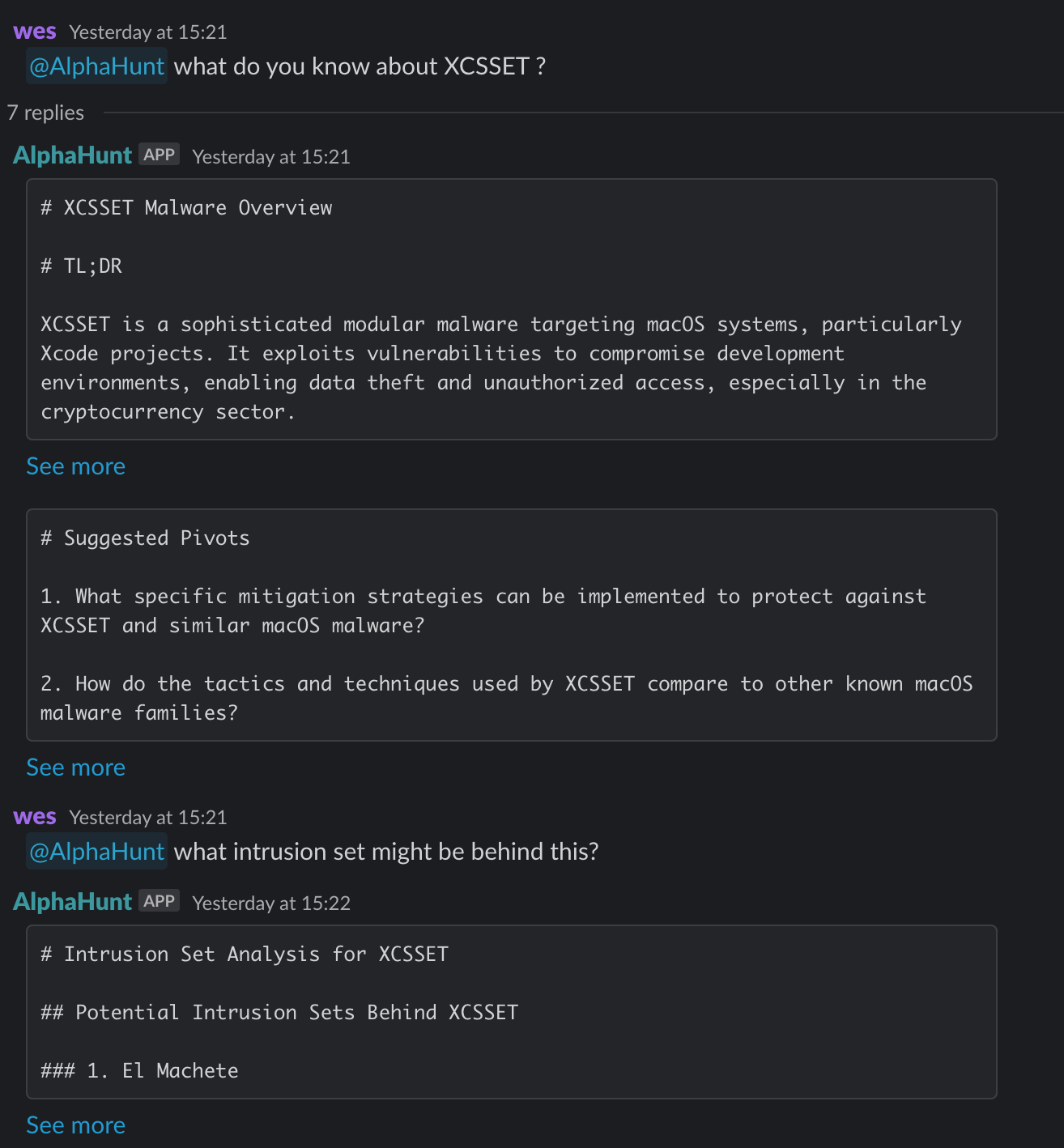XCSSET Malware: Evolving Threats to macOS Development Environments
XCSSET is a sophisticated modular malware strain that primarily targets macOS systems. It was first identified in 2020 and has since evolved, with recent variants incorporating advanced obfuscation and persistence techniques...


EDITOR'S NOTE: I'm testing the next generation of the AlphaHunt- the research goes a bit deeper, a bit more directed and a bit more "peer" reviewed. The layout may still need some work... feedback welcome (just hit reply! :))
TL;DR
Key Points
-
- XCSSET targets macOS systems, specifically through Xcode projects, using advanced obfuscation and persistence techniques.
- Developers should implement robust security tools and practices to prevent infection during software development.
-
- The malware aims for financial gain by stealing sensitive data, including cryptocurrency wallets and passwords.
- Organizations must enhance cybersecurity measures, especially in the financial sector, to protect against data theft.
-
- XCSSET has evolved since 2020, adapting to exploit new macOS vulnerabilities and evade detection.
- Continuous monitoring and updating of security protocols are essential to counteract these evolving threats.
-
- The malware primarily targets countries with high concentrations of macOS users and developers, such as the U.S. and Canada.
- Targeted sectors include technology, finance, and education, necessitating sector-specific security strategies.
Summary
XCSSET is a sophisticated malware strain that targets macOS systems by infecting Xcode projects, allowing it to spread through legitimate software development processes. Initially identified in 2020, it has evolved to incorporate advanced obfuscation and persistence techniques, making detection and removal more challenging. The malware's primary motivation is financial gain, focusing on stealing sensitive information like cookies, passwords, and cryptocurrency wallet data.
The malware has been linked to other macOS-targeting strains such as Silver Sparrow and EvilQuest, which also exploit vulnerabilities for data theft. XCSSET's evolution reflects a broader trend in cyber threats, with attackers refining their tools to bypass security measures. The latest updates, detected in March 2025, indicate ongoing development and active campaigns.
Countries with significant macOS user bases, such as the United States, Canada, and the United Kingdom, are primary targets. The technology, finance, and education sectors are particularly vulnerable due to their reliance on macOS development environments.
To mitigate the threat, organizations should implement advanced security tools, establish comprehensive network monitoring protocols, conduct regular security training, and develop incident response plans. Collaboration with threat intelligence communities is also recommended to stay updated on the latest developments.
In the short term, increased targeting of development environments and financial sector vulnerabilities are expected. In the long term, the proliferation of similar malware and increased regulatory scrutiny will likely drive changes in cybersecurity strategies.
Attribution
Origin
XCSSET is a sophisticated modular malware strain that primarily targets macOS systems. It was first identified in 2020 and has since evolved, with recent variants incorporating advanced obfuscation and persistence techniques. The malware is known for infecting Xcode projects, which are used by developers to create applications for macOS and iOS. This targeting of development environments allows XCSSET to spread through legitimate software development processes. The latest variant, identified in March 2025, features enhanced obfuscation methods and updated persistence mechanisms, making it more challenging to detect and remove (Microsoft, 2025).
Motivation
The primary motivation behind XCSSET appears to be financial gain, as it is designed to steal sensitive information, including cookies, passwords, and cryptocurrency wallet data. The malware's authors leverage its capabilities to compromise user privacy and potentially facilitate further attacks on financial assets. The malware has been observed targeting digital wallets and sensitive data from applications like Notes (BleepingComputer, 2025).
Historical Context
XCSSET has been active since 2020, with its initial variants focusing on stealing user data from macOS applications. Over time, the malware has adapted to exploit vulnerabilities in newer macOS versions and has introduced new features to enhance its evasion tactics. The malware's evolution reflects a broader trend in cyber threats, where attackers continuously refine their tools to bypass security measures. The latest updates represent the first significant changes since 2022, indicating ongoing development and active campaigns (CSO Online, 2025).
Timeline
- 2020: Initial identification of XCSSET malware targeting macOS.
- 2021: Reports of XCSSET evolving to exploit vulnerabilities in macOS applications.
- 2022: Continued updates and adaptations to the malware, including targeting new macOS features.
- 2025: Recent variants detected with enhanced obfuscation and persistence techniques, indicating ongoing development and active campaigns.
Countries Targeted
- United States - High concentration of macOS users and developers, making it a primary target.
- Canada - Similar to the U.S., with a significant number of macOS developers.
- United Kingdom - Notable presence of tech companies and developers using macOS.
- Australia - Growing market for macOS applications and development.
- Germany - Targeted due to its strong tech industry and user base.
Sectors Targeted
- Technology - Direct targeting of software developers and tech companies using Xcode.
- Finance - Focus on stealing cryptocurrency and sensitive financial data.
- Education - Targeting educational institutions with macOS development programs.
- Healthcare - Potential targeting of healthcare applications developed on macOS.
- Retail - Indirect targeting through e-commerce platforms developed for macOS.
Similar Malware
XCSSET has been linked to other malware strains that target macOS, including Silver Sparrow and EvilQuest, which also focus on data theft and exploitation of macOS vulnerabilities.
Similar malware includes:
- Silver Sparrow: Targets macOS systems with a focus on remote access and data theft.
- EvilQuest: Known for its ransomware capabilities alongside data theft.
Threat Actors (Similar?)
XCSSET is believed to be operated by a group of threat actors focused on financial gain through data theft. The specific identities of these actors remain largely unknown, but their tactics suggest a high level of sophistication and adaptability.
Intrusion sets, such as El Machete, Silver Sparrow, and OceanLotus, exhibit a common theme of targeting macOS systems for espionage and data theft. Their motivations range from political and economic espionage to broader regional influence, making them significant threats in the cybersecurity landscape.
1. El Machete
- Description: El Machete is an advanced persistent threat (APT) group known for targeting Latin American entities, particularly in the government and media sectors.
- Motivation: Their activities are primarily driven by political and economic espionage.
- Tactics: Similar to XCSSET, El Machete employs malware techniques to compromise software development environments, indicating a potential overlap in operational tactics.
2. Silver Sparrow
- Description: Silver Sparrow is another threat actor that targets macOS systems, utilizing sophisticated malware techniques, including stealth and evasion tactics.
- Motivation: This group is known for delivering impactful payloads, often targeting high-value systems for espionage and data theft.
- Tactics: The similarities in targeting macOS and employing advanced malware techniques suggest a shared operational focus with XCSSET.
3. OceanLotus (APT32)
- Description: OceanLotus, also known as APT32, is a group that focuses on espionage and data theft, particularly against entities in Southeast Asia.
- Motivation: Their activities are often politically motivated, aiming to exert influence in the region.
- Tactics: OceanLotus shares similar tactics and targets with XCSSET, focusing on macOS and other platforms for espionage.
Breaches Involving This Malware
Recent reports indicate that XCSSET has been involved in limited attacks targeting macOS users, particularly developers. The malware has been linked to breaches where sensitive data, including cryptocurrency wallets, has been compromised (Microsoft, 2025).
Recommendations, Actions, Suggested Pivots, Forecasts and Next Steps..
(Subscribers Only)





